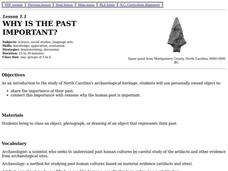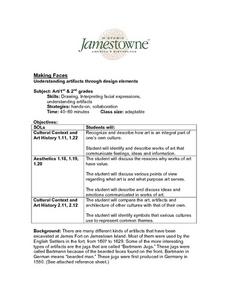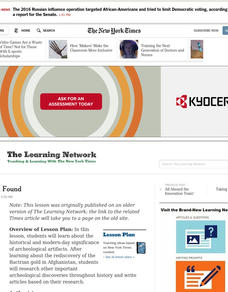Curated OER
Learning from Artifacts Uncovering Clues, Large and Small
Students observe artifacts from Fort St. Louis at a website in order to make inferences about the people who lived there. They paint pottery in the style which might have been used by one of the cultural groups who inhabited the fort.
Curated OER
Classifying Artifacts
Students examine pictures of pottery and classify them. They work together to create a list of characteristics for each piece. They share their findings with the class.
Curated OER
A Museum as Time Capsule
Students focus on museum artwork and artifacts as resources to study history and geography.
Curated OER
Destruction in Bamiyan
Students examine the destruction of the colossal statues of Buddha, carved into sandstone cliffs of Bamiyan, Afghanistan, that were recently demolished by the Taleban. They look for photos of local artifacts that represent the culture...
Curated OER
Digging Deep
Students investigate the job description for archeologists and share their findings with the class. They research a current archeological dig and present their material to the class.
Curated OER
Why is the Past Important?
Fourth graders discuss the importance of North Carolina's archaeological heritage. They share with the class an object, photograph, or drawing of an object that represents their own or their family's past.
Curated OER
Site Robbers
Fourth graders interview a Native American and write a newspaper article or letter that expresses concern about robbing archaeological sites.
Curated OER
"how To Think Like an Archaeologist" Suggested Pre-visit Activity for Historic Jamestowne
Students study grocery receipts to simulate the archaeological activity of classifying items. They discuss the receipts as if they were find lists.
Curated OER
Making Faces: Understanding Artifacts Through Design Elements
Students examine and discuss drinking container artifacts from Jamestown. They view images of the artifacts, discuss their purposes, draw an original facial expression for a brown paper jug, and write a description of the facial expression.
Curated OER
"How to Think Like an Archaeologist" - Suggested Pre-Visit Activity For Historic Jamestown
Learners examine how archaeologists use artifacts to explore other people and their cultures. They discuss types of artifacts, analyze receipts for clues, and discuss how what the items bought reflect about people.
Curated OER
The "Me" Exhibit
Students collects artifacts from home that they feel describe themselves. They write captions for each artifact and display them for their classmates.
Curated OER
Artifacts We Don't Dig Up
Students play a game of artifact show and tell using household items.
Curated OER
A Reporter's Recovery of Place
Young scholars read and write their own story about an artifact they find in their community.
Curated OER
Weaving Heritage Through the Strands of Mountain Windsong
Tenth graders read a novel and then bring in their own artifact with a written description. They also are given a strand to read from certain historical pieces.
Curated OER
Ghana Artifacts
Students study to artifacts from Ghana and discuss how these aid in understanding the civilization.
Curated OER
Clues to the Past
Students take a 1.3 mile walking tour of Chippokes Plantation, inspect significant historic buildings and artifacts, and make inferences about plantation life from their observations while answering a series of questions.
Curated OER
Artifacts: What Am I?
Pupils practice simple Japanese expressions. They explore the information available from artifacts. Groups of students attempt to figure out other groups culture by examining a series of artifacts in a paper bag.
Curated OER
Lost and Found
Students explore the historical and modern-day significance of archeological artifacts. They research other important archeological discoveries throughout history and write articles based on their research.
Curated OER
What's In The Bag?
Pupils research a historical figure from the United States and introduce their classmates to items associated with this person. They also predict how that historical figure would fit into today's society.




















